In May 1999, I received an e-mail message from Donna McLaughlin who lives in
Knoxville, TN. She had come upon some old papers of her grandmother, including a handwritten poem
written by the grandmother when she was a child. The poem was entitled simply FRANK FARRELL.
It describes the sad accidental death of the protagonist, Frank Farrell, on a 'Monday in May' at
'Sweeny's Camp' in 'that famous lumber town'. All Donna knew was that Frank had been her
great-great-uncle and that he was killed by a falling tree somewhere in Sullivan County. Intrigued by her
story and the possible reference to my own ancestors who worked in the lumber industry near the turn of the
previous century, I enlisted the assistance of my Sullivan County cousins and set about finding the true story
of what happened to Frank Farrell. Here it is. We are immensely indebted to Donna McLaughlin for permission to
reproduce her grandmother's poem and for bringing to our attention this fascinating and traumatic incident from
19th Century Sullivan county. Donna can be reached at
MadonnaMac@aol.com .
Prepared by Bob Sweeney
Historical Context:
TThe LUMBER TOWNS
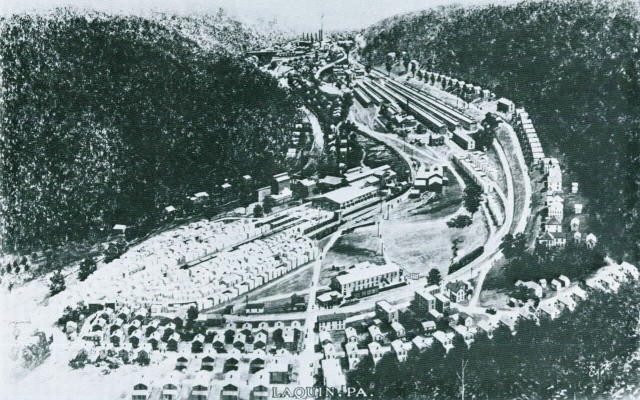
Laquin, Bradford County, PA
A Thriving Lumber Town After Its Founding in 1902
By 1930 an Uninhabited Ghost Lumber Town
In the foreground is the residential area, while the town store is the large building toward the bottom center at the crossroads. The open area to the right of the store is the baseball field where the Laquin team played. Behind the field is the sawmill and kindling wood factory. The stave mill with its long sheds is at top center, and at top is the chemical factory with its tall smoke stacks. This scene was originally drawn by an artist named Spofford for the Barclay family.
Photo of a framed painting auctioned on eBay in November 2005
Photo Submitted by Carol Brotzman
By 1900, Sullivan County was crisscrossed with railroad spurs and lines. From Sonestown
to Hillsgrove, from the "new town" of Laquin just over the border in Bradford County to Lopez and Ricketts, from Masten
in Lycoming County to Kettle Creek west of Eagles Mere, from
Muncy to Dushore and LaPorte and Satterfield, the steam engines labored to carry out the timber. Facing risks we
barely imagine, the lumberjacks, sawmill workers, lumber scalers and railroaders worked long hours to bring the
hemlock and maple tress from remote forest grove to the insatiable American market for wood products. Sullivan County was one of
the most heavily "cut" counties in the United States between 1890 and 1910. An entire industry and lifestyle grew up
around the lumber towns and the smaller lumber camps where seasonal lumberjacks like Pete Sweeney, Frank Farrell, John
Collins, William H. Green and others spent the timber season cutting trees.
Many of the towns are gone today, along with the loggers, sawmills and the lumber industry they supported. When the trees
were cut and the forest cleared away, the lumber companies moved on and the lumber towns declined. For those of us nostalgic
for the old days and places, there is actually an Old Loggers Path that winds through the border area between
Masten and Kettle Creek where the intrepid adventurer can trek the old camps and towns while fending off rattlesnakes! We are indebted to
Janice Decker at jdecker@stny.rr.com
for this information:
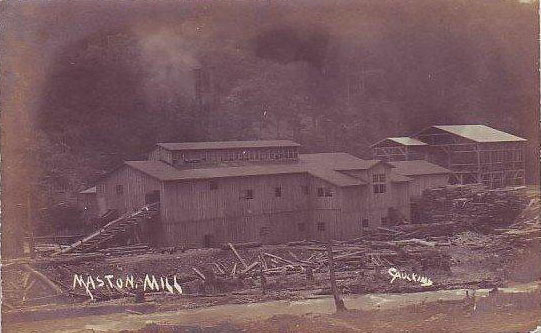
Lumber Mill at Masten, Lycoming County, PA
Photo of an old Caulkins postcard owned by Deb Wilson
The Old Loggers Path runs for 27.1 miles or 43.6 kilometers.
The trail follows many former railroad grades, logging roads, and bark trails - hence the name Old Loggers Path.
The circuit trail is located in northeastern Lycoming County. The starting point is located approximately
2.7 miles southwest of Ellenton on Legislative Route 41110. Look for parking just past the stop
sign in Masten (a ghost lumber town); the starting point is a short distance
(375 ft.) to the right (SW). The town of Ellenton may not appear on some
maps but does appear on the official Pennsylvania maps. This is
the only access in the winter as all the other roads are normally blocked by
snow. The trail is blazed with international orange rectangles. Double blazes warn
of changes in direction. Several other trails are marked with blue
rectangles.The area traversed by the OLP is covered by the Grover, Barbours, Bodines
and Ralston 7.5" U.S.G.S. quadrangles. The trail is located entirely on State Forest Lands,
land that had formerly belonged to the Central Pennsylvania Lumber Co. The trail layout has taken
advantage of the engineering expertise of the early logging railroaders as
it follows the grades. The highlights of the trail are the many cuts & fills
on the grades, Rock Run (one of the prettiest streams in Pennsylvania), the
vistas that look into the McIntyre Wild Area, Pleasant Stream, and the
Loyalsock Trail region. Information and a free map can be obtained from:
Tiadaghton State Forest
423 E. Central Avenue
S. Williamsport, PA 17701
717-327-3450
Also, the road into the nearby ghost lumber town of Kettle Creek in Sullivan county is dirt, unnamed
and follows the old railroad bed. It is a very pretty area to investigate, but beware of the
snakes. When we had reunions down there in Augusts past, part of the activity
was a rattlesnake hunt by some of the more courageous family members. We
stopped having reunions there when a rattlesnake came out from under the
porch of the hunting lodge as we were getting ready to sit down to dinner
one year.
The scenery may have been beautiful but the job was dangerous, however. Any informal examination of obituaries
and newspaper stories from the Sullivan Review
during the boom years would point to hundreds of deaths and serious injuries in the timber industry. H
ere is just one example:
Sullivan Review
Dushore, PA
June 16, 1892
Ricketts.
--Last week while Wm. Green was peeling bark for Trexler and Turrell, a dry limb fell from a tree above his head and struck him on the side of the neck entering just inside the collar bone, going straight down toward the lung. The limb broke off about an inch below the skin. After the piece was removed it measured about five inches. At the present writing Mr. Green is very low and no hope is entertained of his recovery, as he is falling all the time. Later: Mr. Greene [sic] died at noon Monday.
Here is another that occurred in the same year:
Sullivan Review
Dushore, PA
February 18, 1892
Killed by a Log.
While "banking" saw logs on King's Creek, in Elkland township, on Friday, February 12, 1892, Wm. White was
crushed beneath a heavy log, and lived about half an hour. He was at work in company with
Robert Reed, and a large log had been rolled to its place in the pile, but wouldn't stay there.
White told Reed he would hold the log while Reed rolled another down to hold it. Another large
log was started, slipped around, and went plunging endwise. White dropped his hook and started to run,
but lost his footing and fell, the log struck him on the head and crushed it. His companion put him on
the sled and started the horses for home, but the unfortunate man was dead before a mile was covered.
He was about 25 years old, and leaves a wife and two small children. Funeral and interment Sunday at
Sugar Ridge.
Even in the 1990's in the modern timber industry , cutting wood was still one of the two or three most injury-prone professions in
the United States. It is this historical context that we ask you to keep in mind as we go back in time to a world
that no longer exists--the late 19th century lumber industry.
Look at the town of Ricketts in 1899, as seen from where the Lehigh Valley Railroad enters town and forks. This community
on the border of Sullivan and Luzerne counties was the quintessential lumber town, built and nourished entirely by the lumber
industry. Along these tracks, the lumberjacks and other forest workers fanned out in work groups, often living in camps for weeks at
a time while they spent all day chopping and felling the giant trees.
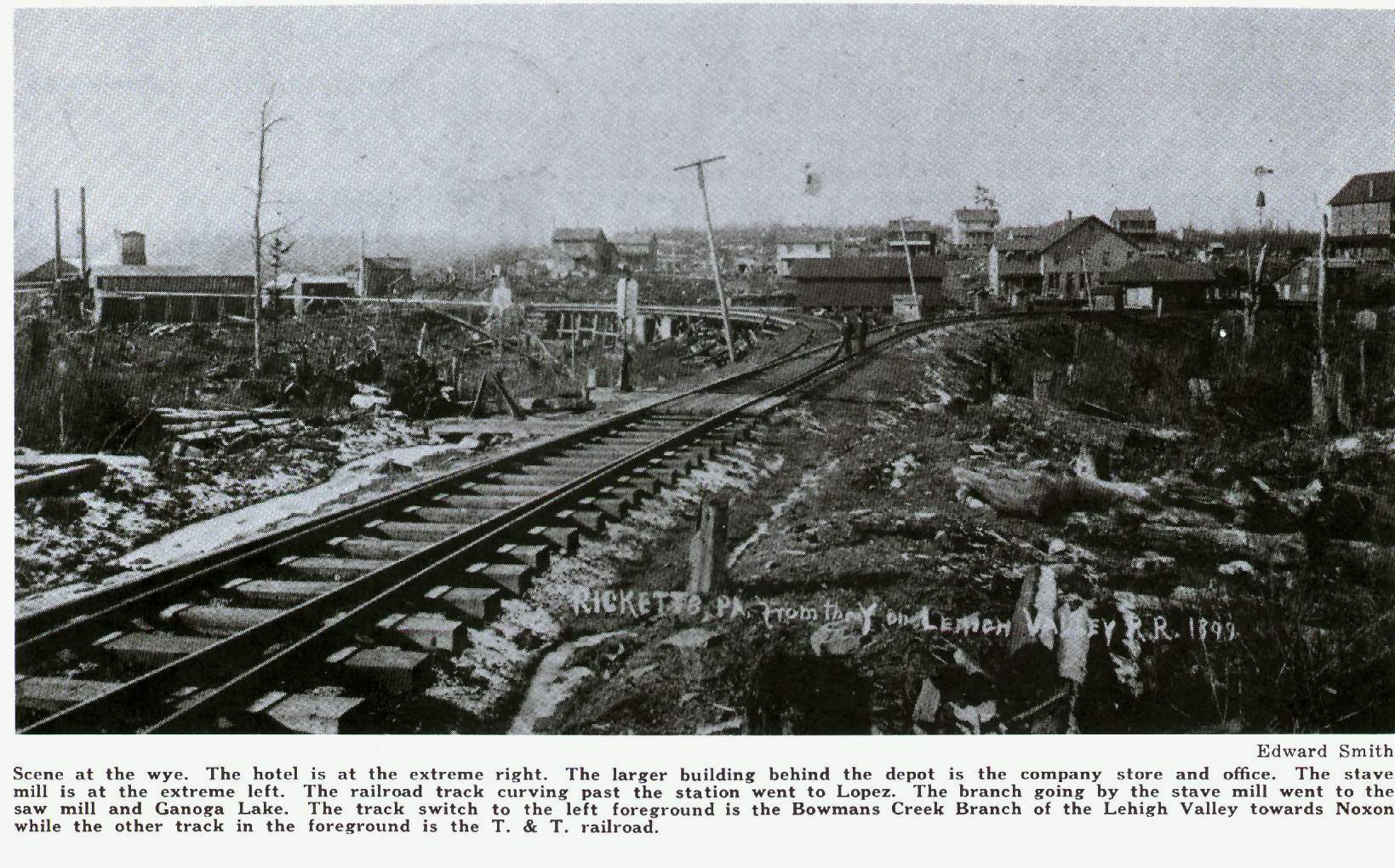
Source: Thomas Tabor III, Ghost Lumber Towns of Central Pennsylvania, 1970, Muncy, PA
A second view shows us the Klondyke Camp near Lopez in 1899. This camp was administered by the largest lumber company,
Jennings Brothers, and illustrates how the entire life of the lumber men and their families was built around these seasonal camps.
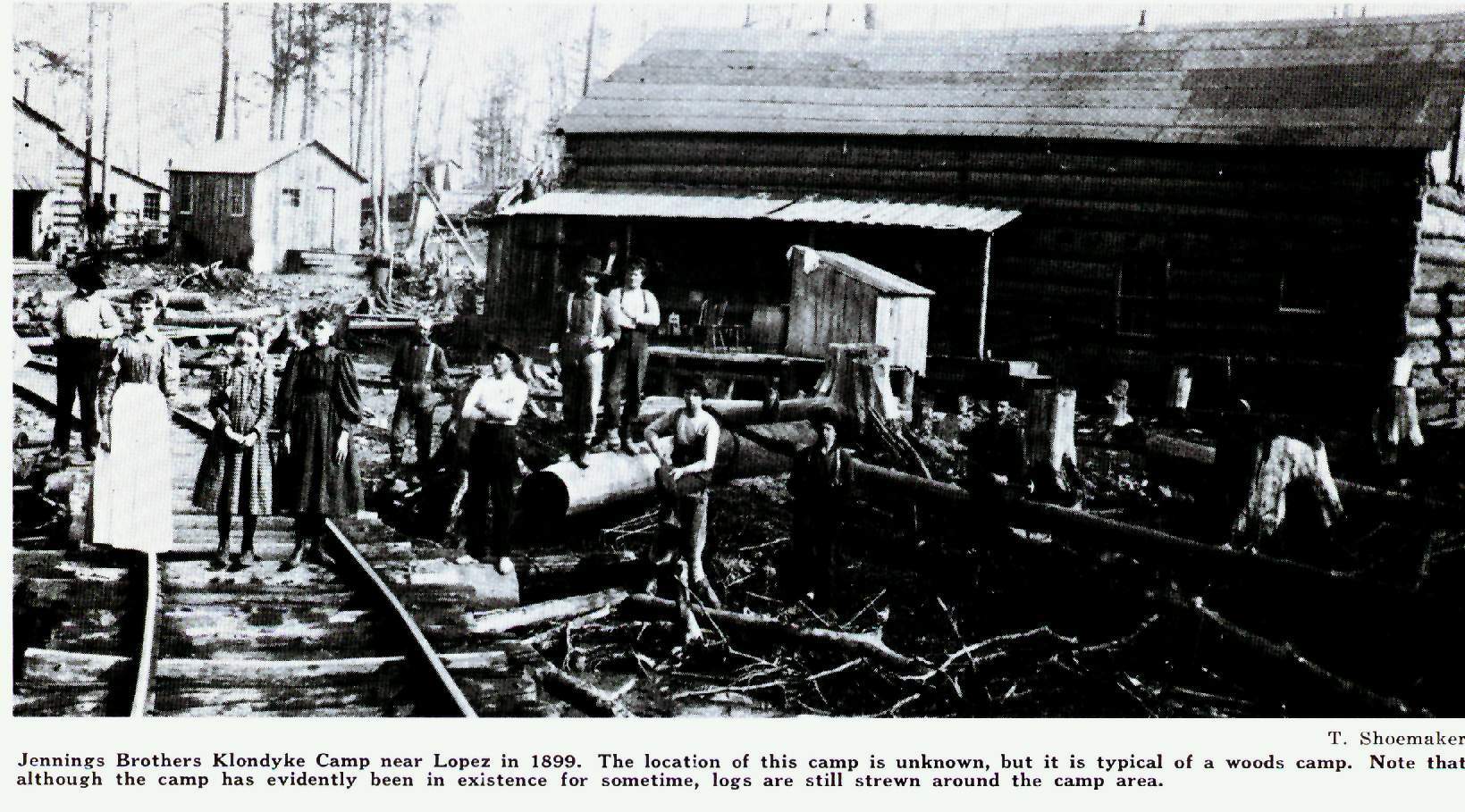
Source: Thomas Tabor III, Ghost Lumber Towns of Central Pennsylvania, 1970, Muncy, PA
The story of Frank Farrell begins with the death of an old lady in 1975, ELIZABETH MIDDENDORF WATSON. Elizabeth
was born in 1892 in Dushore and was the daughter of Frank Middendorf and Mary Catherine FARRELL. The Middendorf family
had its own story of emigration and growth in Sullivan County, but that is for another tale. You can find some of this information at
The Middendorf and Waples Families. In our story, we are
particularly interested in Mary Catherine Farrell and her siblings. She had twelve brothers and sisters for a total of 13
children. The parents of this large but typical brood were James Farrell and Ann O'DONOVAN. Frank Farrell's father James Farrell was a son of Patrick Farrell,
of County Longford, Ireland. Patrick married Bridget Kinsley, and they arrived in Cherry in 1840. They had seven boys, including James. Patrick died in 1865 at the age of 64.
Bridget's death is recorded in the Sullivan Review for March 3, 1881. Frank Farrell,
born in 1866, was one of these children and therefore the brother of Mary Catherine Farrell and the uncle of
Elizabeth Middendorf. In 1998 or thereabouts, 23 years after Elizabeth had passed away, her grand-daughter Donna Mclaughlin
came into some of her old papers and possessions. Among those was a poem that Elizabeth had written as a little girl:
Here it is:
FRANK FARRELL
I am a land that has seen trouble
and sorrow, many accidents occurred
I will sing to you the latest.
No doubt that you have heard
It was out in Sullivan County
and known to all throughout the land
is that famous lumbering town.
The robins were singing in the
merry month of May
Frank Farrell left his home so
happy and so gay, and little
thinking about the danger
in the forest, trees so tall and sound,
that swept away many a loving son
in that famous lumbering town.
It was on a Monday morning
he began his daily toil.
Little did his brother think, he
soon would lie beneath the soil,
parted from a loving father and
laid by his mother's mound,
never to hear those stately hemlocks
fall in that famous lumbering town.
The brothers a tree were cutting
and to the earth did fall.
It caught a limb of a maple,
Jerry, to his brother did call.
It shot down like an arrow,
and it crushed Frank to the ground
and killed, there by his brother's
side, in the famous lumbering town.
Now, Frank in his grave is sleeping
and the hemlocks creak and wave,
and little we know which one of
us will next go to the grave.
Whenever we visit this sun sweet
tree, that strove by Frank's mound
Who met his grave in Sweeny's
Camp, in that famous lumber town.
When Donna first sent me a a copy of this handwritten simple poem, I was overwhelmed with
sadness and nostalgia, simultaneously. Sadness for the little girl who worte this poem,
perhaps after a visit to the accident or grave site with her mother! Nostalgia for the
grandfather and great uncles I never knew who cut the lumber and lived life in the forest
when Frank met his fate, and perhaps were even at his side in "Sweeny's Camp"! While I had no
idea where the camp had been located and even less of an idea the identify of "that famous
lumbering town", it became a personal obsession to find the ghost of Frank Farrell in the pages of
Sullivan County history. But where to start? The accident could have happened any time between
approximately 1860, when Farrell families lived in the area and the sons and grandsons of Michael
Sweeney began to cut lumber to supplement their incomes, and the mid-1920's when the lumber industry
died out in Sullivan County.
To the rescue rode Fred and Jenny Everetts who identified a note in the Towanda Weekly Review
for May 22, 1891. The report said that a Frank Farrell was reported dead in Dushore at age 25. Another note
from the Reporter Journal, dated May 28, 1891, said that a Frank Farrell, age 25,
was killed last week in Ricketts! So, now we had a good presumption that the accident happened in May 1891 in
or near Ricketts, PA,, which had to be "that famous lumbering town". The next thing I did was contact my McDonald cousins still
living in Sullivan County--Ray and Linda Karge McDonald. They sat down and began to scan the old records of the
Sullivan Review for the time period of interest. Soon enough they had the whole story from the old
Dushore newspaper archives.
The Sullivan Review
Dushore, PA
May 28, 1891
A young man by the name of Merrick traveled the nine miles between Ricketts and Lopez in one
hour and fifteen minutes Monday morning to bring news of the unfortunate death of Frank Farrell.
He made the distance on foot over the ties of the rail way track and reached there in time to send an engine and car
after the body of his fellow workman. A professional runner couldn't have done better.
Killed in the Woods- Frank Farrell was killed Monday morning about 7:00 o'clock while chopping
trees on Sweeney's job one mile above Ricketts. He had just cut a large hemlock and in felling it broke a dead
limb about one foot in diameter from a large maple nearby, and the maple limb struck young Farrell
on the head. He died in about 20 minutes, but was unconscious from the first. His brother was alone
with him at the time of the accident. The remains were brought to Dushore on the afternoon train and conveyed
to his father's residence in Cherry. The funeral and interment occurred on Wednesday at St. Basil's.
Deceased was a highly exemplary young man, a son of James F. Farrell, aged about 24 years, whose sudden
and violent death has cast a gloom over his large circle of friends and relatives. Truly, in the
midst of life, we are in death.
The funeral of Frank Farrell on Wednesday last was one of the largest in this place for years. There
were over 80 carriages in line and the church was packed to its utmost capacity by the Patrick T. _______, group
of people.
In the 1870 federal census for Cherry Township (page 19B, Reel # 593-1453), the Farrell family
can be found. There was Frank, born in 1866, and his sister Mary Catherine, future mother of Elizabeth,
born in 1868. We also find Anna and George and an adopted daughter named Ann Donovan, presumably the child of
a previous marriage by her mother. The family was young then and tragedy had not descended on the oldest son.
Clearly from the newspaper story, Frank would grow up to be a popular and widely respected citizen of Cherry.
also, from what else we know, he joined the Sweeney family in their annual campaigns to the woods as lumber men.
What was it like in the forest? We don't know but we do have some pictures that give us at least a reasonable impression. Take a
look at the next picture, provided graciously by Don Collins, that shows a turn-of-the-century lumber gang on break.
We believe that at least some of these men are members of the Collins family, but do not know for sure. What we do know is
that the background, dress and equipment are typical for what Frank Farrell would have encountered and been familiar
with.
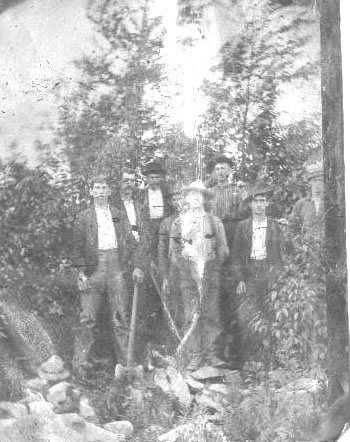
Source: Don Collins, personal collection
Yet another picture may press even closer to the tragic life of Frank Farrell. We know that he worked with the
Sweeney family, my direct ancestors, and that he died in fact on their "job". The next picture, taken some time around
the turn of the century, shows two of the Sweeney brothers, James "Big Jim" Sweeney [likely] and John W. Sweeney [positively identified], cutting timber,
most likely at the family camp. That camp was run by Patrick Sweeney, their first cousin (more below), once removed.
However, the time is probably a few years after the Farrell accident just due to the known ages of the men in the
picture. Jim Sweeney was born in 1862 and John W. in 1870. When Jim died in 1931, he was listed as a "lumber scaler" for profession on his obituary.
John became a farmer. Both men were brothers to my own grandfather Peter Francis "Pete" Sweeney, who worked in the woods with his older brothers before becoming a railroad man. In a second picture,
taken in Salamanca, New York about 1915-1920, we see, in old age, two other Sweeneys who "majored" in the timber industry. Patrick Sweeney, on the left, and Michael
Sweeney, Jr., on the right were sons of Michael Sweeney, the original immigrant,and uncles to Big Jim, John and Pete. Patrick moved
west to Elk and McKean counties in the 1870's and eventually ran two saw mills in that area. Michael lived most of his life in the Sullivan
County area and, as late as 1920, listed himself as a woodsman in the 1920 federal census. So, some or all of these men were among
the Sweeneys that Frank Farrell grew up with in and around Cherry, knew and worked with until the day he died.
We know directly from another newspaper account published in Dushore that young Farrell was working for Patrick Sweeney:
The Republican
Dushore, PA
May 22, 1891
Frank Farrell of Dushore, while working in the bark woods in the employ of Pat Sweeney on or near the Mehoopany Creek in Colley twp. Was instantly killed on Monday at about 8:30 a.m. by a fallen limb or a piece of a tree top which had lodged in
the tree he and his brother Jerry were in the act of cutting down.
Jerry saw the limb about 12 feet in the air sprang and informed Frank at the same time. Frank made a desperate struggle for life, but was too late. The limb came down like a cannon ball striking him on the head crushing it to a mash and one limb piercing his side.
Deceased was brought to Dushore on the same day of the accident and the burial took place on Wednesday in the Catholic cemetery at said place.
Frank and Jerry are sons of James Farrell of Dushore, and were not old experienced woodsmen. Frank having served but one season in the bark woods requested of Mr. Sweeney that he and his brother Jerry who was receiving his first lesson, be allowed to work in the same gang, as he desired to make it as easy as possible for his younger brother.
Mr. Sweeney granted them this favor knowing at the time that it would be better for them to divide and each accept an old woodsman as their companion, but not wishing to confront the boys granted them the request as above state.
Deceased was a model young man of about 24 years of age and had hosts of friends throughout the county who speak of him in the kindest of terms. The bereaved family have the sincere sympathy of the entire community in their sad affliction.
The Republican
May 22, 1891
Dushore Items
Frank Farrell, a sober and industrious young man, eldest son of James Farrell of this place met with a fatal accident Monday morning. He was employed in the woods at Mehoopany Creek beyond Lopez by Patrick Sweeney and felled a tree, which tore a large branch from a maple near by. The limb from the maple struck the unfortunate young man on the head and he lived but a few minutes. The remains were brought to this place Monday afternoon and interred in St. Basilís cemetery on Wednesday.
Patrick Sweeney was the nephew of Michael and Catherine Sweeney, the original emigrants to Sullivan County in 1843. Born in 1852 on Ringer Hill to Patrick Sweeney, brother of Michael and Catherine Sweeney, and Catherine Donahoo,
he was orphaned at age two in 1854 when his father died or was killed. Both Patricks are buried at
St. Basil's Cemetery in Dushore. The younger Patrick later became a teamster and worked in the Connell Mines, where he was injured by a mule in December 1921. He died a few months later in 1922, leaving a widow, Elizabeth Kinsley, and three daughters. Catherine Donahoo remarried to Edward Nolan, a local farmer, after the death of her first husband. She outlived Edward as well, bearing at least four children. Catherine and two of her daughters are buried in the woods behind Sacred Heart Church in Laporte, PA. You can see pictures of their tombstones at the bottom of the Sacred Heart Cemetery page. Catherine died in May, 1897.
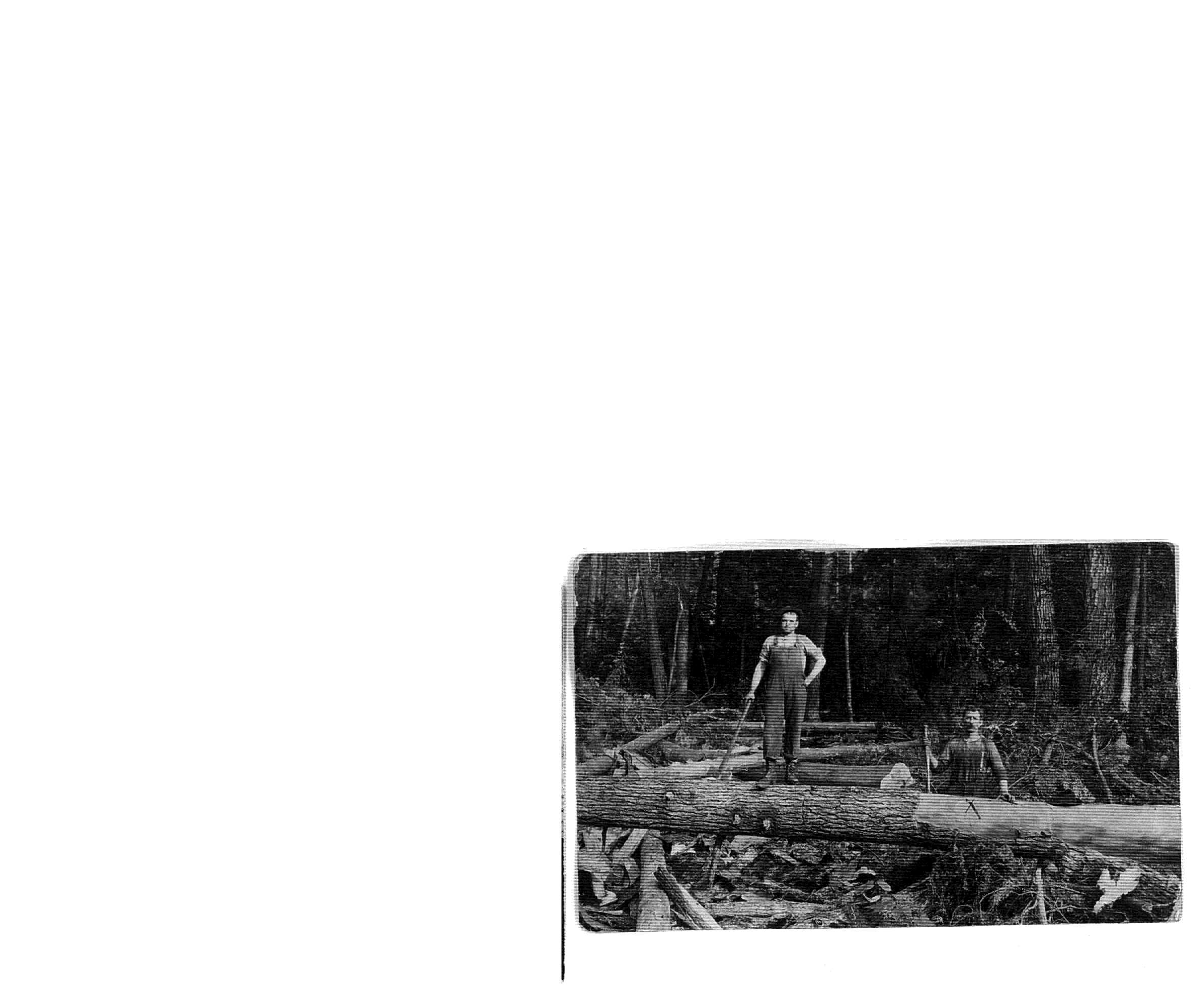
John Sweeney [right] and possibly his brother James "Big Jim" Sweeney
Sons of Martin and Julia (Wright) Sweeney
Source: Rose Marie Sweeney, personal collection
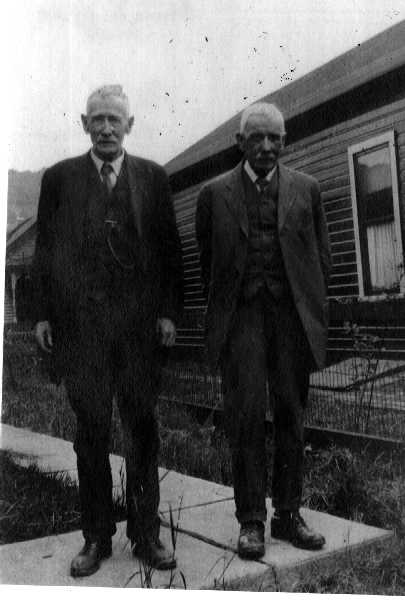
Source: Thomas and Mary F. Sweeney, personal collection
Sweeney's Camp was apparently a well recognized labor camp in the 1890s. The year after the death of Frank Farell, a destructive fire in the camp was reported as follows in the same issue where the accidental death of William Green was noted:
Sullivan Review
Dushore, PA
June 16, 1892
--The Sweeney Camp was burned to the ground last Thursday. Everything was lost. The loss falls heavily on the boys as they lost all their clothes except those they had on and they of course were not of the best.
The company have taken out the stalls and put in bunks for the men to sleep in the barn and are building an addition to the blacksmith shop for a cook room.
If you go to Ricketts today, you find that much of the old forest area is now a state park. The forest
is beautiful and quiet. There are still stands of hemlock trees that escaped the axe and the saw. There are even
old railroad tracks running toward Lopez to the north. In fact, Ricketts itself is a ghost town as you can see at:
Ricketts.
We can almost imagine that Frank Farrell is watching from a hidden
forest shadow! Does he ask us to remember him and the simple poem his niece wrote? Does he ask that we not forget what
happened in that "famous lumbering town"?
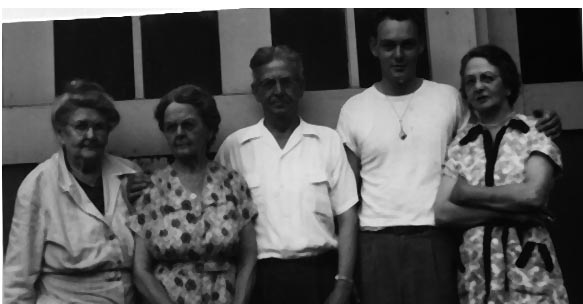
L to R: Mary Catherine Farrell, Agatha Farrell (another sister to Frank Farrell), Ed
Middendorf (son of Mary Catherine), Tom O'Brien McLaughlin (Donna's father), Elizabeth
Middendorf Watson (author of the poem); 1954. Source: Donna Mclaughlin.
|